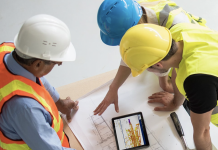Can the majority of the construction industry meet the April 2016 deadline? Duncan Reed, Digital Construction Process Manager at Trimble Tekla, considers where we are in the BIM journey…
This burning question has been discussed a lot throughout the industry – ever since the government announced that BIM should be mandatory on all their funded projects from April 2016. So, will the industry meet the deadline?
The government’s BIM strategy will impact on many parts of the industry, but it does not directly affect the whole industry. Therefore, whilst I do not think everyone will be ready, does that really matter?
There are still many misconceptions in the industry about BIM being nothing more than a fancy piece of 3D modelling software when in reality it has huge potential – so it is important that businesses understand the facts. BIM is a process that can, and will, bring efficiencies to companies’ existing processes in order to deliver projects quickly, competently and more reliably for clients.
Instead of businesses being unnerved about the future of construction, this is a time for the industry to grab the opportunities that working digitally presents, collaborate and share experiences and best practice. By doing so, it will help businesses deliver BIM in a way that is beneficial to them. Indeed, every business can benefit from the adoption of BIM – no matter whereabouts in the construction chain they lie – they just first need to understand what that benefit is for them.
There is plenty of technology available to help support businesses in making this step change towards digital construction. However, some businesses are already working digitally and have not realised that they are on the right path to being BIM level two compliant. For example, companies that are using software for the programing of works or quantity takes offs are technically implementing BIM processes, but they may not be considering this as ‘doing BIM’.
So for me the 2016 date isn’t so much a deadline as a target along the way of a longer journey for construction. The journey is to move from analogue to digital. The industry has successfully embraced email for the most part but we all have those days when you can’t find a message. This is an example of unstructured data, Level 0 in the government’s terminology, even if a very basic one, but it reinforces the fact that the important bit about BIM is getting a structure in place so that everyone can find information quickly and easily.
In the same way, a well-structured, data rich, constructable model from a designer offers major benefits to the contractor and the wider supply chain to re-use this data in order to reduce waste and improve project outcomes. The data set can be expressed in whatever form is relevant to the organisation wanting to use the data – whether that is 2D drawings, a link to programmes, creating schedules or viewing the project as a 3D model.
Once fully designed, the model becomes the project’s database for producing and extracting all the information about the asset. What’s more, there is software available, such as Trimble Tekla that is capable of producing these highly detailed schedules and drawings, combined with the ability to precisely build and visualise the large and diverse quantities of material involved, further aiding accurate forecasting and project understanding.
With these procedures in mind, it is clear to see that a BIM process is relevant to all parties working in construction. Where businesses do have concerns over becoming digital and entering into the world of BIM, there are many templates available on the market that have been designed to assist the industry – whether they are working on a government funded project or not.
As such, with the tools and technology already being used, businesses just need to look at ways of sharing information in an agreed manner and, by doing so, they’ll be BIM ready before they know it.
Duncan Reed
Digital Construction Process Manager
Trimble Tekla
Tel: +44 (0)113 887 9790
www.twitter.com/Trimble_TeklaUK











